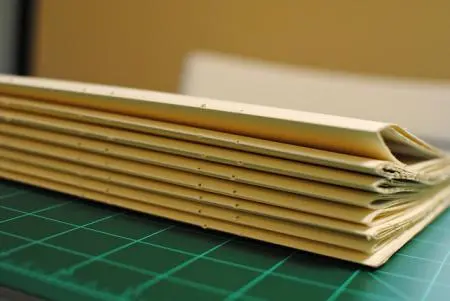Image via thefutureofpublishing.com
Books are like bodies — it’s hard to get rid of them. If a librarian is caught throwing books into a dumpster — and we could be talking about science textbooks from the 60’s that still refer to the Brontosaurus — bad press will follow. Suddenly, we’re all monsters for trashing the sacred cow. Like bodies, books display infinite variety and at the same time are all basically the same; they share a common anatomy.
Let’s geek out and learn the vocabulary.
At the heart of each book (and let’s focus on traditional hardcover items) is paper. Pieces of paper are folded and grouped together into signatures. If you pull out any hardcover book and look at the top edge near the spine, you will see these little groupings of paper. The signatures are sewn together, which you can observe as a number of threads running down the middle of a signature. After sewing, a piece of backing material (cloth or paper) is glued to the signatures to hold them together.

At this point, the groups of signatures, now called the text block, are fitted into the case, or cover. Hardcover books consist of three boards: one for the front cover, one for the back, and one for the spine. Boards are typically made out of hard cardboard and have been consistently covered with cloth since the 19th century, but there is also a parallel (cheaper) practice of using printed paper. This eliminates the need for a bookjacket.
Once the text block has been affixed to the front and back covers, endpapers are added to hold it in place. Endpaper is heavier than the printed pages of your book, and for centuries marveled paper was the endpaper of choice. One page of the endpaper is glued to the inside of the cover (called the paste down) and the other becomes the first and last page of the book (called the fly leaf or free endpaper).
Unless your publisher is a total cheapskate, you will find colored bands of thread at the head and tail of the spine. These are called endbands, and they date from medieval times. While endbands once served to protect the textblock, these days they are purely decorative.
Congratulations! Now you know more about book structure than all of your friends. But you can go oh so much deeper. Two lines of inquiry seem to entice book enthusiasts: rare books and manuscripts, and the book as aesthetic object.
Rare Books and Manuscripts
Beware! The pursuit of rare books and manuscripts leads to obsession and sad financial straights. Rare books are considered rare for a variety of reasons — they're first editions of critical works (everything by Shakespeare), they document an important moment in history or scientific learning (Gutenberg Bible), they're inscribed or annotated by the author, or they contain something beautiful and handmade (The Book of Kells). Usually the information contained in the book can be found in reproductions or reprints, but there is something incredibly special about the original. That's why researchers still flock to archives and museums to view the original manuscripts of the works they're studying, as nothing comes close to Mozart's handwritten score for The Marriage of Figaro or a first edition of William Blake's The First Book of Urizen. There is no shortage of rare book and manuscript dealers, but I recommend AbeBooks as a good place to start. You can also learn more about the study of rare books through the Rare Book School, which even offers a certificate program.
The Book as Aesthetic Object
If your personal library is full of paperback books, you may not share this view. That’s because paperbacks are disposable books. None of the basics of bookbinding apply to them. The paper is unbelievably cheap, often acidic (meaning it turns brittle and yellow with age), and the pages are glued to the spine. There is no artistic quality to a paperback. Hardcover books, on the other hand, enjoy an incredibly long and rich history as fine examples of craft. It may surprise you to know that what we think of as a book, called a codex, emerged in the first few centuries AD, when people started folding papyrus instead of rolling it into scrolls. By 800 AD, the format was standardized, and for the next 1,000 years, not a lot changed in the process of bookmaking. The introduction of the printing press by Gutenberg in 1450 meant text no longer had to be handwritten, yet book structure remained the same. It was only in the 19th century that mechanization of book binding took off, and while the process has become more and more automated, the structure of the hardbound book has remained virtually unchanged in modern history.
Something about that ubiquitous codex structure is just begging for manipulation, which is exactly what book and paper artists do. This interesting subset of the art world uses the building blocks of the codex as raw materials for handmade art. Many colleges and universities around the country offer an MFA in Book and Paper Arts, and some even offer community classes. (You can find a short list at the College Book Art Association website.) Students learn printing techniques, how to make paper by hand, and a wide variety of bookmaking styles. The exhibits at these institutions make me drool, as their students push the boundaries of what you ever thought possible with this medium.
If you've never taken a bookmaking class before, do it! It's fun and you get to use tools with names like "awl" and "bone folder." I promise, you will never look at a book the same way again.

About the author
Stephanie Bonjack is an academic librarian and musician who lives and works on the Colorado Front Range. She teaches the relentless pursuit of information, and illuminates the path to discovery. She has presented at national and international library conferences, and is especially interested in how libraries evolve to serve the needs of 21st century patrons.







